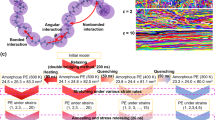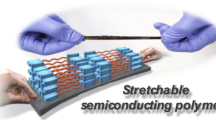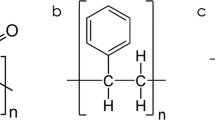Abstract
Thermal conductivity is an important property for polymers, as it often affects product reliability (for example, electronics packaging), functionality (for example, thermal interface materials) and/or manufacturing cost1. However, polymer thermal conductivities primarily fall within a relatively narrow range (0.1–0.5 W m−1 K−1) and are largely unexplored. Here, we show that a blend of two polymers with high miscibility and appropriately chosen linker structure can yield a dense and homogeneously distributed thermal network. A sharp increase in cross-plane thermal conductivity is observed under these conditions, reaching over 1.5 W m−1 K−1 in typical spin-cast polymer blend films of nanoscale thickness, which is approximately an order of magnitude larger than that of other amorphous polymers.
This is a preview of subscription content, access via your institution
Access options
Subscribe to this journal
Receive 12 print issues and online access
$259.00 per year
only $21.58 per issue
Buy this article
- Purchase on Springer Link
- Instant access to full article PDF
Prices may be subject to local taxes which are calculated during checkout




Similar content being viewed by others
References
Chanda, M. & Roy, S. K. Plastics Technology Handbook 4th edn (CRC Press/Taylor Francis Group, 2007).
Mamunya, Y. P., Davydenko, V. V., Pissis, P. & Lebedev, E. Electrical and thermal conductivity of polymers filled with metal powders. Eur. Polym. J. 38, 1887–1897 (2002).
Wong, C. P. & Bollampally, R. S. Thermal conductivity, elastic modulus, and coefficient of thermal expansion of polymer composites filled with ceramic particles for electronic packaging. J. Appl. Polym. Sci. 74, 3396–3403 (1999).
Shen, S., Henry, A., Tong, J., Zheng, R. T. & Chen, G. Polyethylene nanofibres with very high thermal conductivities. Nature Nanotech. 5, 251–255 (2010).
Singh, V. et al. High thermal conductivity of chain-oriented amorphous polythiophene. Nature Nanotech. 9, 384–390 (2014).
Wang, X. J., Ho, V., Segalman, R. A. & Cahill, D. G. Thermal conductivity of high-modulus polymer fibers. Macromolecules 46, 4937–4943 (2013).
Kurabayashi, K., Asheghi, M., Touzelbaev, M. & Goodson, K. E. Measurement of the thermal conductivity anisotropy in polyimide films. J. Microelectromech. Syst. 8, 180–191 (1999).
Choy, C. L. Thermal conductivity of polymers. Polymer 18, 984–1004 (1977).
Allen, P. B., Feldman, J. L., Fabian, J. & Wooten, F. Diffusons, locons and propagons: Character of atomic vibrations in amorphous Si. Phil. Mag. B 79, 1715–1731 (1999).
Hsieh, W. P. et al. Testing the minimum thermal conductivity model for amorphous polymers using high pressure. Phys. Rev. B 83, 174205 (2011).
Shenogin, S., Bodapati, A., Keblinski, P. & McGaughey, A. J. H. Predicting the thermal conductivity of inorganic and polymeric glasses: The role of anharmonicity. J. Appl. Phys. 105, 034906 (2009).
Regner, K. T. et al. Broadband phonon mean free path contributions to thermal conductivity measured using frequency domain thermoreflectance. Nature Commun. 4, 1640 (2013).
O’Brien, P. J. et al. Bonding-induced thermal conductance enhancement at inorganic heterointerfaces using nanomolecular monolayers. Nature Mater. 12, 118–122 (2013).
Yamamoto, O. & Kambe, H. Thermal conductivity of cross-linked polymers—comparison between measured and calculated thermal conductivities. Polym. J. 2, 623–628 (1971).
Mark, J. E. Physical Properties of Polymers Handbook (AIP Press, 1996).
Steiner, T. The hydrogen bond in the solid state. Angew. Chem. Int. Ed. 41, 48–76 (2002).
Utracki, L. A. Polymer Blends Handbook (Kluwer Academic Publishers, 2002).
Kunal, K., Robertson, C. G., Pawlus, S., Hahn, S. F. & Sokolov, A. P. Role of chemical structure in fragility of polymers: A qualitative picture. Macromolecules 41, 7232–7238 (2008).
Coleman, M. M. & Painter, P. C. Hydrogen-bonded polymer blends. Prog. Polym. Sci. 20, 1–59 (1995).
Lin, A. A., Kwei, T. K. & Reiser, A. On the physical meaning of the Kwei equation for the glass-transition temperature of polymer blends. Macromolecules 22, 4112–4119 (1989).
Lee, S. M. & Cahill, D. G. Heat transport in thin dielectric films. J. Appl. Phys. 81, 2590–2595 (1997).
Borca-Tasciuc, T., Kumar, A. R. & Chen, G. Data reduction in 3ω method for thin-film thermal conductivity determination. Rev. Sci. Instrum. 72, 2139–2147 (2001).
Jin, Y. S., Shao, C., Kieffer, J., Pipe, K. P. & Shtein, M. Origins of thermal boundary conductance of interfaces involving organic semiconductors. J. Appl. Phys. 112, 093503 (2012).
Koh, Y. K. et al. Comparison of the 3ω method and time-domain thermoreflectance for measurements of the cross-plane thermal conductivity of epitaxial semiconductors. J. Appl. Phys. 105, 054303 (2009).
Kikugawa, G., Desai, T. G., Keblinski, P. & Ohara, T. Effect of crosslink formation on heat conduction in amorphous polymers. J. Appl. Phys. 114, 034302 (2013).
Losego, M. D., Moh, L., Arpin, K. A., Cahill, D. G. & Braun, P. V. Interfacial thermal conductance in spun-cast polymer films and polymer brushes. Appl. Phys. Lett. 97, 011908 (2010).
Jin, Y. et al. Thermal boundary resistance of copper phthalocyanine–metal interface. Appl. Phys. Lett. 98, 093305 (2011).
Liu, J., Ju, S. H., Ding, Y. F. & Yang, R. G. Size effect on the thermal conductivity of ultrathin polystyrene films. Appl. Phys. Lett. 104, 153110 (2014).
Stauffer, D. & Aharony, A. Introduction to Percolation Theory 2nd edn (Taylor & Francis, 1992).
Rong, W. R., Fan, Z. Y., Yu, Y., Bu, H. S. & Wang, M. Influence of entanglements on glass transition of atactic polystyrene. J. Polym. Sci. Part B 43, 2243–2251 (2005).
Lemstra, P. J. & Kleintjens, L. A. Integration of Fundamental Polymer Science and Technology-2 222–226 (Elsevier Applied Science, 1988).
Magonov, S. N., Elings, V. & Whangbo, M. H. Phase imaging and stiffness in tapping-mode atomic force microscopy. Surf. Sci. 375, L385–L391 (1997).
Podsiadlo, P. et al. Ultrastrong and stiff layered polymer nanocomposites. Science 318, 80–83 (2007).
Underwood, W. M. & Taylor, J. R. Thermal-conductivity of several plastics determined by an improved line-source apparatus. Polym. Eng. Sci. 18, 556–563 (1978).
Acknowledgements
This work was supported by the US Department of Energy (DOE), Office of Basic Energy Sciences, as part of the Center for Solar and Thermal Energy Conversion in Complex Materials, an Energy Frontier Research Center (DE-SC0000957). This work was also partly supported by the Converging Research Center Program funded by the Ministry of Science, ICT and Future Planning (Project No. 2014M3C1A8048791). G-H.K. also acknowledges a PISET fellowship from the University of Michigan Energy Institute. All authors acknowledge the Lurie Nanofabrication Facility and Electron Microbeam Analysis Laboratory for sample preparation and characterization.
Author information
Authors and Affiliations
Contributions
G-H.K. conceived the initial ideas with the help of K.P.P., and measured and analysed the thermal conductivity and AFM data. J.K., D.L. and A.S. designed the polymer systems. D.L., A.S. and G-H.K. prepared the polymer blend films. D.L. and A.S. measured and analysed FTIR spectroscopy data. L.S. deposited metal patterns and measured film thicknesses. G-H.K., A.S., and M.S.K. measured and analysed DSC data. D.L. measured GIXS. D.G. measured PALS. J.K. and K.P.P. supervised the work. G-H.K. wrote the manuscript with contributions from all authors, and J.K. and K.P.P. revised the manuscript.
Corresponding authors
Ethics declarations
Competing interests
The authors declare no competing financial interests.
Supplementary information
Supplementary Information
Supplementary Information (PDF 3827 kb)
Rights and permissions
About this article
Cite this article
Kim, GH., Lee, D., Shanker, A. et al. High thermal conductivity in amorphous polymer blends by engineered interchain interactions. Nature Mater 14, 295–300 (2015). https://doi.org/10.1038/nmat4141
Received:
Accepted:
Published:
Issue Date:
DOI: https://doi.org/10.1038/nmat4141
This article is cited by
-
Roll-to-roll fabricated polymer composites filled with subnanosheets exhibiting high energy density and cyclic stability at 200 °C
Nature Energy (2024)
-
Polymer nanocomposite dielectrics for capacitive energy storage
Nature Nanotechnology (2024)
-
Improvement of compressible regular solution model using Sanchez-Lacombe equation of state for phase behavior prediction of polymer blends
Polymer Bulletin (2024)
-
Ladderphane copolymers for high-temperature capacitive energy storage
Nature (2023)
-
Computational indentation in weakly cross-linked polymer networks
International Journal of Advances in Engineering Sciences and Applied Mathematics (2023)



